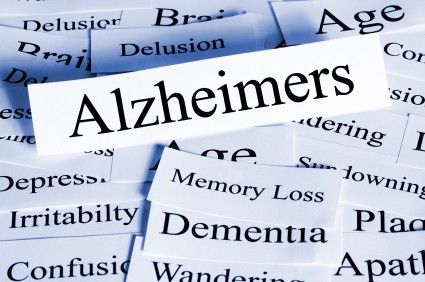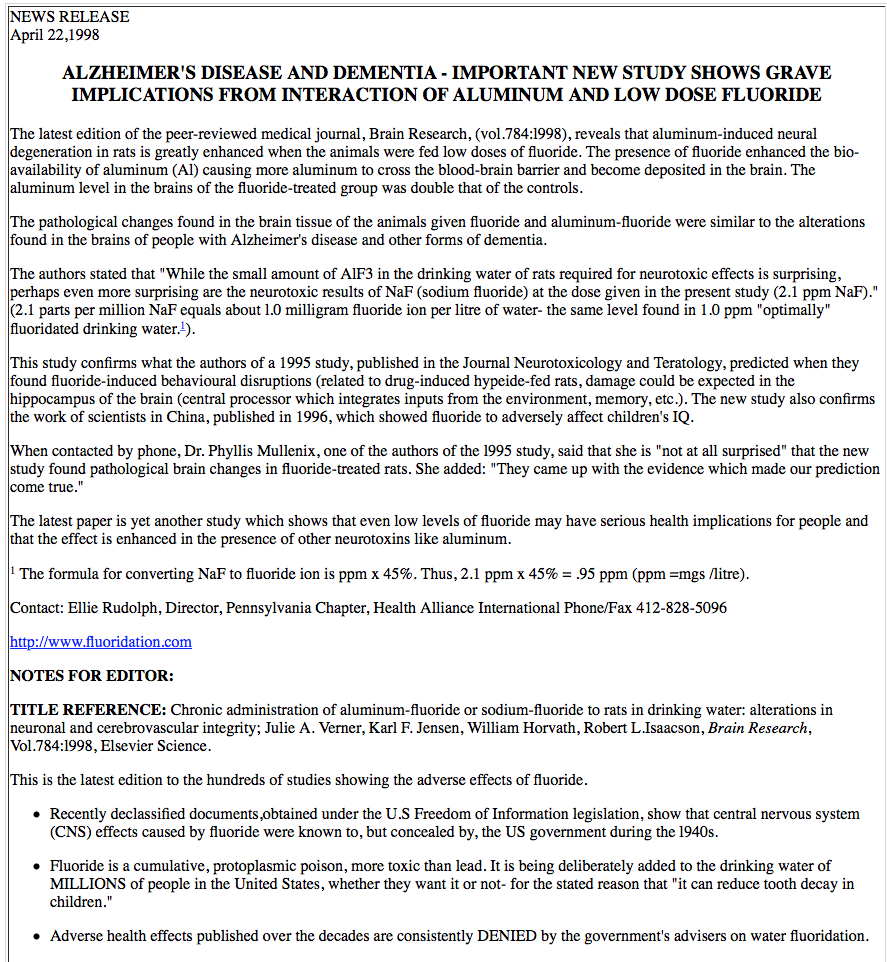
Health Implications from the Interaction of Aluminium and a Low Dosage Fluoride, relating to the onset of Alzheimers and Dementia.
From a peer-reviewed medical journal, “Brain Research,” (vol. 784:1998), revealed that aluminium-induced neural degeneration in rats is greatly enhanced when the animals were fed low doses of fluoride. The presence of fluoride enhanced the bio-availability of aluminium (Al) causing more aluminium to cross the blood-brain barrier and become deposited in the brain. The aluminium level in the brains of the fluoride-treated group was double that of the controls.[1]
The pathological changes found in the brain tissue of the animals given fluoride and aluminium-fluoride were similar to the alterations found in the brains of people with Alzheimer’s disease and other forms of dementia. The authors state that “While the small amount of AIF3 in the drinking water of rats required for neurotoxic effects is surprising, perhaps even more surprising are the neurotoxic results of NaF (sodium fluoride) at the dose given in the present study (2.1 ppm NaF).” (2.1 parts per million NaF equals about 1.0 milligram of fluoride icon per litre of water — the same level found in 1.0 ppm “optimally” fluoridated drinking water.)[2]
This study confirms what the authors of a 1995 study, published in the Journal “Neurotoxicology and Teratology” predicted, when they found fluoride-induced behavioural disruptions (related to drug-induced hyperactivity and cognitive deficits). The authors anticipated that given the behavioural disorders found in fluoride-fed rats, damage could be expected in the hippocampus of the brain (central processor which integrates inputs from the environment, memory, etc.). The new study also confirms the work of scientist in China, published in 1996, which showed fluoride to adversely affect children’s IQ.
When contacted by phone, Dr. Phyllis Mullenix, one of the authors of the 1995 study, said that she is “not at all surprised” that the new study found pathological brain changes in fluoride-treated rats. She added: “They came up with the evidence which made our prediction come true.”
The latest paper is yet another study which shows that even low levels of fluoride may have serious health implications for people and that the effect is enhanced in the presence of other neurotoxins like aluminium.
Correspondence: Ellie Rudolph, Health Alliance International, Director, Pennsylvania Chapter, phone/fax (412/828-5096. Scientific and Professional comments on the “Report of the Expert Panel for Water fluoridation Review” at: http://www.cadvision.com/fluoride/report.htm.
Notes
1 Chronic administration of aluminium-fluoride or sodium-fluoride to rats in drinking water: alterations to neuronal and cerebrovascular integrity: Julie A. Verner, Karl F. Jensen, William Horvath, Robert L. Isaacson, Brain Research, Vol. 784:1998, Elsevier Science.
2 The formula for converting NaF to fluoride ion is ppm x 45%. Thus, 2.1 ppm x 45% = .95 ppm (ppm=mgs/litre). Recently declassified documents, obtained under the US Freedom of Information Legislation, show that central nervous system (CNS) effects caused by fluoride where known to, but concealed by the US government during the 1940s. Adverse health effects published over the decades are consistently denied by the government’s advisers on water fluoridation.
Further Study
Cancers, Tumours, Autism, Diabetes, what is really going on?
Curing Cancer without the Chemistry, take control of your body
HSV-1 herpes and liquorice : how to treat herpes simplex-1 with liquorice
Developing a School Emergency Response Plan Guidance for Governors and Head-teachers
Holistic doctors mysterious deaths, they uncovered cancer agent in vaccines
How the sweetener Aspartame affects the brain
85% of tampons contain cancer causing glyphosate
Vaccine adjuvant squalene, is it safe for elderly patients?
